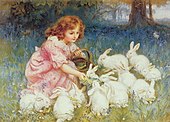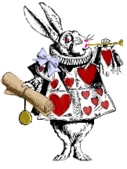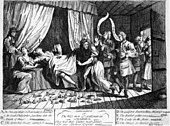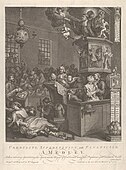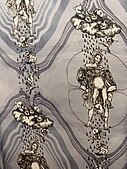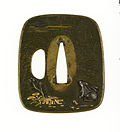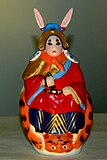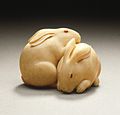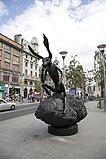Rabbits and hares in art


Rabbits and hares (Leporidae) are common motifs in the visual arts, with variable mythological and artistic meanings in different cultures. The rabbit as well as the hare have been associated with moon deities and may signify rebirth or resurrection.[1] They may also be symbols of fertility or sensuality, and they appear in depictions of hunting and spring scenes in the Labours of the Months.
Judaism

In
Classical Antiquity
In
Christian art

In Early Christian art, hares appeared on reliefs, epitaphs, icons and oil lamps although their significance is not always clear.
The

The Hasenfenster (hare windows) in Paderborn Cathedral and in the Muotathal Monastery in Switzerland, in which three hares are depicted with only three ears between them, forming a triangle, can be seen as a symbol of the Trinity, and probably go back to an old symbol for the passage of time. Though they have six ears, the three hares shown in Albrecht Dürer's woodcut, The Holy Family with Three Hares (1497), can also be seen as a symbol of the Trinity.[citation needed]
The idea of rabbits as a symbol of vitality, rebirth and resurrection derives from antiquity. This explains their role in connection with
The phenomenon of superfetation, where embryos from different menstrual cycles are present in the uterus, results in hares and rabbits being able to give birth seemingly without having been impregnated, which caused them to be seen as symbols of virginity.[6] Rabbits also live underground, an echo of the tomb of Christ.

As a symbol of fertility, white rabbits appear on a wing of the high altar in
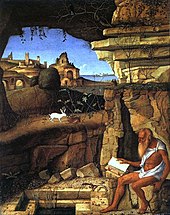
Hunting scenes in the sacred context can be understood as the pursuit of good through evil. In the Romanesque sculpture (c. 1135) in the Königslutter imperial Cathedral, a hare pursued by a hunter symbolises the human soul seeking to escape persecution by the devil. Another painting, Hares Catch the Hunters, shows the triumph of good over evil. Alternatively, when an eagle pursues the hare, the eagle can be seen as symbolizing Christ and the hare, uncleanliness and the evil's terror in the face of the light.
In Christian iconography, the hare is an attribute of Saint Martin of Tours and Saint Alberto di Siena, because legend has it that both protected hares from persecution by dogs and hunters. They are also an attribute of the patron saint of Spanish hunters, Olegarius of Barcelona. White hares and rabbits were sometimes the symbols of chastity and purity.[8]
In secular art

In non-religious art of the modern era, the rabbit appears in the same context as in antiquity: as prey for the hunter, or representing spring or autumn, as well as an attribute of Venus and a symbol of physical love. In cycles of the Labours of the Months, rabbits frequently appear in the spring months. In Francesco del Cossa's painting of April in the Palazzo Schifanoia in Ferrara, Italy, Venus' children, surrounded by a flock of white rabbits, symbolize love and fertility.
In
As small animals with fur, hares and rabbits allowed the artist to showcase his ability in painting this difficult material. Dead hares appear in the works of the earliest painter of still life collections of foodstuffs in a kitchen setting, Frans Snyders, and remain a common feature, very often sprawling hung up by a rear leg, in the works of Jan Fyt, Adriaen van Utrecht and many other specialists in the genre. By the end of the 17th century, the grander subgenre of the hunting trophy still life appeared, now set outdoors, as though at the back door of a palace or hunting lodge. Hares (but rarely rabbits) continued to feature in the works of the Dutch and Flemish originators of the genre, and later French painters like Jean-Baptiste Oudry.[9]
From the Middle Ages until modern times, the right to hunt was a vigorously defended privilege of the ruling classes. Hunting Still lifes, often in combination with hunting equipment, adorn the rooms of baroque palaces, indicating the rank and prestige of their owners. Jan Weenix' painting shows a still life reminiscent of a trophy case with birds and small game, fine fruits, a pet dog and a pet monkey, arranged in front of a classicising garden sculpture with the figure of Hercules and an opulent palace in the background. The wealth and luxurious lifestyle of the patron or owner is clearly shown.
The children's tales of the English author
Joseph Beuys, who always finds a place for a rabbit in his works, sees it as symbolizing resurrection. In the context of his action "How to Explain Pictures to a Dead Hare", he stated that the rabbit "...has a direct relationship to birth... For me, the rabbit is the symbol of incarnation. Because the rabbit shows in reality what man can only show in his thoughts. He buries himself, he buries himself in a depression. He incarnates himself in the earth, and that alone is important."
Masquerade (book) (1979), written and illustrated by the artist Kit Williams, is ostensibly a children's book, but contains elaborate clues to the location of a jewelled golden hare, also made by Williams, which he had buried at the location in England to which the clues in the book led. The hare was not found until 1982, in what later emerged as dubious circumstances.
The Welsh sculptor Barry Flanagan (1944-2009) was best known for his energetic bronzes of hares, which he produced throughout his career. Many have a comic element, and the length and thinness of the hare's body is often exaggerated.
Dürer's Young Hare

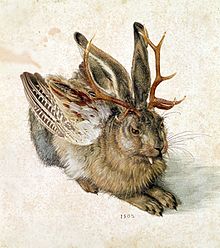
Probably one of the most famous depictions of an animal in the history of European art is the painting
The hare pictured by Dürer probably does not have a symbolic meaning, but it does have an exceptional reception history. Reproductions of Dürer's Hare have often been a permanent component of
Since early 2000, Ottmar Hörl has created several works based on Dürer's Hare, including a giant pink version.[12] Sigmar Polke has also engaged with the hare on paper or textiles, or as part of his installations,[13] and even in rubber band form.[14] Dieter Roth's Köttelkarnikel ("Turd Bunny") is a copy of Dürer's Hare made from rabbit droppings,[15] and Klaus Staeck enclosed one in a little wooden box, with a cutout hole, so that it could look out and breathe. Dürer's Hare has even inspired a depiction of the mythological Wolpertinger.
Depictions of Mary Toft Birthing Rabbits
William Hogarth depicted Mary Toft giving birth to rabbits in 1726 in the etchings Cunicularii or The Wise Men of Godliman in Consultation (1726) and Credulity, Superstition, and Fanaticism (1762).[16][17][18] Mary Toft was a woman who convinced many medical professionals and the public at the time that she was birthing rabbits, when it was, in fact, a hoax.[19] Inspired by the work of William Hogarth, artist Amelia Biewald resurrected the story of Mary Toft into the gallery with The Curious Case of Mary Toft in 2020.[20][21][22]
Gallery
-
Pisanello: Vision of St. Eustace, 1435
-
Scene from A Midsummer Night's Dream. Titania and Bottomwith white rabbits, 1851
-
Feedingwhite rabbits, Frederick Morgan, Paris
-
TheAlice in Wonderland
-
Rabbits eating grapes
-
Ferdinand du Puigaudeau, Chinese Schadows, the Rabbit
-
Boy and Rabbit, by Henry Raeburn 1814
-
Zan Zig performing with rabbit and roses, magician poster, 1899
-
White rabbit standing, by Jan Mankes, 1910
-
Cunicularii or The Wise Men of Godliman in Consultation, William Hogarth, 1726
-
Credulity, Superstition, and Fanaticism, William Hogarth, 1762
-
The Curious Case of Mary Toft, Wallpaper, Amelia Biewald, 2019
- Sculptures and objects representing rabbits and hares
-
Rabbit-shaped incense burner, Japan, 19th century
-
Japanesetsubasword fitting with a "Rabbit Viewing the Autumn Moon", bronze, gold and silver, between 1670 and 1744
-
Rabbit Figurine
-
Tureen, 1754, Chelsea Porcelain Manufactory, England
-
Netsuke with rabbit
- Sculptures representing rabbits and hares
-
The Rabbit statue is one of the 12 Chinese zodiac portrayed in the Kowloon Walled City Park in Kowloon City, Hong Kong
-
Jose de Creeft, Statue of Alice in Central Park, 1959
-
Bronze hare by Barry Flanagan, in Dublin
-
Der Hase by Jürgen Goertz in Nuremberg
See also
- How to Explain Pictures to a Dead Hare
- List of fictional hares and rabbits
- Moon gazing hare
- Moon rabbit
- Rabbits in culture and literature
Notes
References
- ^ a b
Windling, Terri (2005). "The Symbolism of Rabbits and Hares". Endicott Studio. Archived from the original on 3 May 2012.
{{cite web}}: CS1 maint: unfit URL (link) - Deuteronomy14:7
- ^ Wonnenberg, Felice Naomi. "How do the rabbits get into the synagogue? From China via Middle East and Germany to Galizia: On the tracks of the ROTATING RABBITS SYMBOL". googlepages.com. Archived from the original on 8 September 2010. Retrieved 13 August 2011.
- ^ Herodotus, The Histories 3.108
- ^ Physiologus. Ed. by Ursula Treu. 3rd edition. Hanau 1998. pp. 103–104 (German).
- ISBN 0-8018-9789-0. p. 122.
- ISBN 0-948462-18-3
- ^ "the-symbolism-of-rabbits-and-hares". bunniesinbaskets.org. Retrieved 1 September 2014.
- ^ Talbot, William S., "Jean-Baptiste Oudry: Hare and Leg of Lamb", p. 150, The Bulletin of the Cleveland Museum of Art, Vol. 57, No. 5 (May, 1970), pp. 149-158 , Cleveland Museum of Art, JSTOR
- ^ "Hase nach Albrecht Dürer". www.martin-missfeldt.de.
- ^ "Wie erklärt man einem toten Hasen die Kunst (How to explain art to a dead hare) Fluxus-Aktion" (in German). Retrieved 23 April 2012.
- ^ Smyth, Debbie (26 March 2015). "Pink Rabbit!". Travel with Intent. Retrieved 8 March 2018.
- ^ "Illustration, Gouache on patterned fabric".
- ^ Butler, Sharon (5 June 2012). "More on Prince, Polke, and rubber bands". Two Coats of Paint. Retrieved 8 March 2018.
- ^ "Multimedial: Künstler Roth". leben.freenet.de.
- ^ The curious case of Mary Toft. University of Glasgow Library Special Collections Department. (2009). https://www.gla.ac.uk/myglasgow/library/files/special/exhibns/month/aug2009.html
- ^ Krysmanski, B. (1998). We see a ghost: Hogarth’s satire on methodists and.. Art Bulletin, 80(2), 292.
- ^ "print; satirical print | British Museum". www.britishmuseum.org. Retrieved 29 November 2023.
- ^ Mary Toft of Goldyman, England, and Her Extraordinary Delivery of Seventeen Rabbits in 1726. (1980). Pediatrics, 66(4), 539.
- ^ "Amelia Biewald". Maake Magazine. Retrieved 29 November 2023.
- ^ Rosalux (17 November 2022). "ARTIST 2 ARTIST with Amelia Biewald". Rosalux Gallery. Retrieved 29 November 2023.
- ^ "The Curious Case Of Mary Toft |". www.ameliabiewald.com. Retrieved 7 December 2023.
- )
Literature
- Guy de Tervarent: Attributs et symboles dans l'art profane. Genève 1997. pp. 287–288. ISBN 978-2-600-00507-4
- Lexikon der christlichen Ikonographie. Established by Engelbert Kirschbaum. Ed. Wolfgang Braunfels. Herder Verlag, Freiburg im Breisgau 1968–1976. ISBN 978-3-451-22568-0
External links
- Windling, Terri (2005). "The Symbolism of Rabbits and Hares". Endicott Studio. Archived from the original on 3 May 2012.
{{cite web}}: CS1 maint: unfit URL (link) - Online-Kunst.de on hares in the arts (in German)
- Article "Hase" in: Kunstlexikon by P. W. Hartmann (in German)
- Wie erklärt man einem toten Hasen die Kunst (How to explain art to a dead hare) Fluxus-Aktion (in German)



